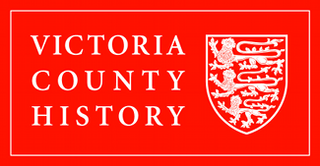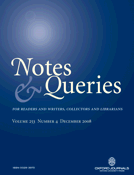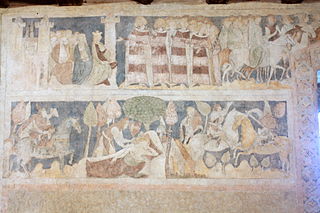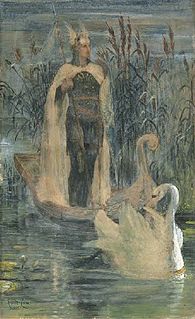Related Research Articles

King Arthur was a legendary British leader who, according to medieval histories and romances, led the defence of Britain against Saxon invaders in the late 5th and early 6th centuries. The details of Arthur's story are mainly composed of folklore and literary invention, and modern historians generally agree that he is unhistorical. The sparse historical background of Arthur is gleaned from various sources, including the Annales Cambriae, the Historia Brittonum, and the writings of Gildas. Arthur's name also occurs in early poetic sources such as Y Gododdin.

The Round Table is King Arthur's famed table in the Arthurian legend, around which he and his knights congregate. As its name suggests, it has no head, implying that everyone who sits there has equal status. The table was first described in 1155 by Wace, who relied on previous depictions of Arthur's fabulous retinue. The symbolism of the Round Table developed over time; by the close of the 12th century it had come to represent the chivalric order associated with Arthur's court, the Knights of the Round Table.

The Victoria History of the Counties of England, commonly known as the Victoria County History or the VCH, is an English history project which began in 1899 and was dedicated to Queen Victoria with the aim of creating an encyclopaedic history of each of the historic counties of England. In 2012 the project was rededicated to Queen Elizabeth II in celebration of her Diamond Jubilee year. Since 1933 the project has been coordinated by the Institute of Historical Research in the University of London.
Constantine was a 6th-century king of Dumnonia in sub-Roman Britain, who was remembered in later British tradition as a legendary King of Britain. The only contemporary information about him comes from Gildas, who castigated him for various sins, including the murder of two "royal youths" inside a church. The historical Constantine is also known from the genealogies of the Dumnonian kings, and possibly inspired the tradition of Saint Constantine, a king-turned-monk venerated in Southwest Britain and elsewhere.
Boydell & Brewer is an academic press based in Woodbridge, Suffolk, England that specializes in publishing historical and critical works. In addition to British and general history, the company publishes three series devoted to studies, editions, and translations of material related to the Arthurian legend. There are also series that publish studies in medieval German and French literature, Spanish theatre, early English texts, in other subjects. Depending on the subject, its books are assigned to one of several imprints in Woodbridge, Cambridge (UK), or Rochester, New York, location of its principal North American office. Imprints include Boydell & Brewer, D.S. Brewer, Camden House, the Hispanic series Tamesis Books, the University of Rochester Press, James Currey, and York Medieval Press.

Notes and Queries is a long-running quarterly scholarly journal that publishes short articles related to "English language and literature, lexicography, history, and scholarly antiquarianism". Its emphasis is on "the factual rather than the speculative". The journal has a long history, having been established in 1849 in London; it is now published by Oxford University Press.
Gaheris or Gaheries is a character in the Arthurian legend, a nephew of King Arthur and a knight of the Round Table, the third son of Arthur's sister or half-sister Morgause and her husband Lot, King of Orkney and Lothian. He is the younger brother of Gawain and Agravain, and the older brother of Gareth and half-brother of Mordred. In Thomas Malory's popular Le Morte d'Arthur, Gaheris is little more than a supporting character to Gawain and Gareth, with the murder of Morgause an odd exception, but his role is greater in the French prose cycles. He and Gareth are both killed by Lancelot during his rescue of Guinevere.

Kemp Malone was a prolific medievalist, etymologist, philologist, and specialist in Chaucer who was lecturer and then professor of English Literature at Johns Hopkins University from 1924 to 1956.

The Lancelot–Grail, also known as the Vulgate Cycle or Pseudo-Map Cycle, is an early 13th-century literary cycle consisting of interconnected prose episodes of chivalric romance in Old French. A lengthy source of Arthurian legend, the cycle focuses on the love affair between Lancelot and Guinevere as well as the quest for the Holy Grail, expanding on the works of Robert de Boron and Chrétien de Troyes. After its completion around 1230-1235, the Lancelot–Grail was soon followed by its major rewrite known as the Post-Vulgate Cycle.

Lohengrin is a character in German Arthurian literature. The son of Parzival (Percival), he is a knight of the Holy Grail sent in a boat pulled by swans to rescue a maiden who can never ask his identity. His story, which first appears in Wolfram von Eschenbach's Parzival, is a version of the Knight of the Swan legend known from a variety of medieval sources. Wolfram's story was expanded in two later romances. Richard Wagner's opera Lohengrin of 1848 is based upon the legend.
Perlesvaus, also called Li Hauz Livres du Graal, is an Old French Arthurian romance dating to the first decade of the 13th century. It purports to be a continuation of Chrétien de Troyes' unfinished Perceval, the Story of the Grail, but it has been called the least canonical Arthurian tale because of its striking differences from other versions.

Richard William Barber FRSL FSA FRHistS is a British historian who has published several books about medieval history and literature. His book The Knight and Chivalry, about the interplay between history and literature, won the Somerset Maugham Award, a well-known British literary prize, in 1971. A similarly-themed 2004 book, The Holy Grail: Imagination and Belief, was widely praised in the UK press, and received major reviews in The New York Times and The New Republic.
Debra A. Kemp was an American author.
Norris J. Lacy is an American scholar focusing on French medieval literature. He is the Edwin Erle Sparks Professor Emeritus of French and Medieval Studies at the Pennsylvania State University. He is a leading expert on the Arthurian legend and has written and edited numerous books, papers, and articles on the topic. In 2014 the International Arthurian Society, North American Branch, presented him an award for Lifetime Service to Arthurian Studies.
Kairo-kō: A Dirge is a 1905 novel by the Japanese author Natsume Sōseki. The earliest, and only major, prose treatment of the Arthurian legend in Japanese, it chronicles the adulterous love triangle between Lancelot, Guinevere, and Elaine of Astolat.

Merlin is a partially lost epic poem in which Robert de Boron reworked Geoffrey of Monmouth's material about the legendary figure of Merlin, writing in Old French sometime in either the late 12th or early 13th century. Merlin tells the stories of the origin and early life of Merlin, his role in the birth of Arthur, and how Arthur became the king of Britain. It emphasises Merlin's power to prophesy as well as his connection to the Holy Grail. Merlin introduced a number of new motifs that later became popular in medieval and later Arthuriana, also ensuring the lasting place of Merlin as a key character in the legend of King Arthur.

The Catholic Record Society, founded in 1904, is a scholarly society devoted to the study of Reformation and post-Reformation Catholicism in England and Wales. It has been described as "the premier Catholic historical society in the United Kingdom", and has been credited with making much otherwise obscure archival material more readily available.
Michael Lapidge, FBA is a scholar in the field of Medieval Latin literature, particularly that composed in Anglo-Saxon England during the period 600–1100 AD; he is an emeritus Fellow of Clare College, Cambridge and Fellow of the British Academy, and winner of the 2009 Sir Israel Gollancz Prize.
Moriaen is a 13th-century Arthurian romance in Middle Dutch. A 4,720-line version is preserved in the vast Lancelot-Compilatie, and a short fragment exists at the Royal Library at Brussels. The work tells the story of Morien, the Moorish son of Aglovale, one of King Arthur's Knights of the Round Table.
Sebile, alternatively written as Sedile, Sebille, Sibilla, Sibyl and other similar names, is a mythical medieval queen or princess who is frequently portrayed as a fairy or an enchantress in the Arthurian legends and Italian folklore. She appears in a variety of roles, from the most faithful and noble lady to a wicked seductress, often in relation with or substituting for the character of Morgan le Fay. Some tales feature her as a wife of either King Charlemagne or Prince Lancelot, and even as an ancestor of King Arthur.
References
- ↑ Arthurian Literature I. Archived 2015-05-20 at the Wayback Machine Boydell & Brewer. Retrieved 19 May 2015.
- ↑ Lacey, Norris J. (2006). A History of Arthurian Scholarship. Cambridge: D.S. Brewer. p. 57. ISBN 978-1-84384-069-5.
- ↑ Arthurian Literature XXXII. Archived 2015-05-20 at the Wayback Machine Boydell & Brewer. Retrieved 19 May 2015.
- ↑ "Reviews", Francoise Le Saux, Notes and Queries, (1996) 43 (2): 203-204.
| This article about a non-fiction book on literature or literary criticism is a stub. You can help Wikipedia by expanding it. |